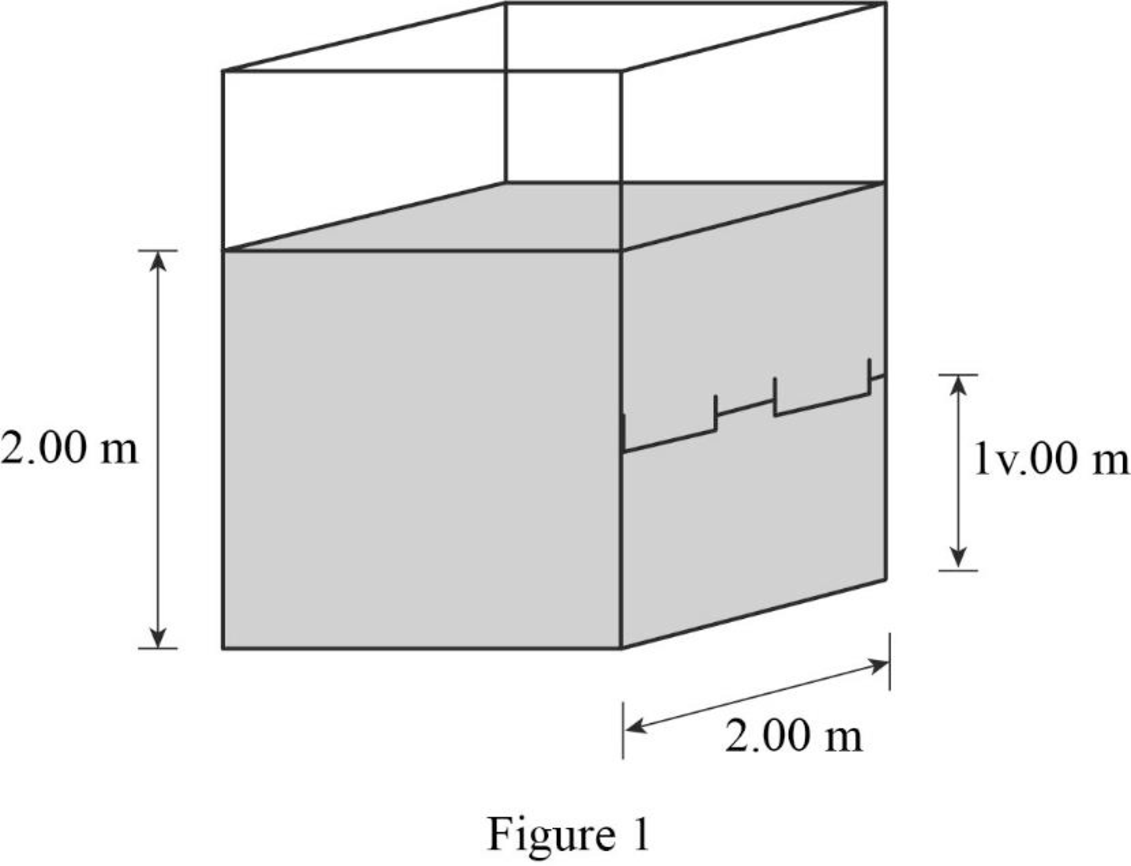
Concept explainers
Review. The tank in Figure P15.13 is filled with water of depth d = 2.00 m. At the bottom of one sidewall is a rectangular hatch of height h = 1.00 m and width w = 2.00 m that is hinged at the top of the hatch. (a) Determine the magnitude of the force the water exerts on the hatch. (b) Find the magnitude of the torque exerted by the water about the hinges.

(a)
The magnitude of the force the water exerts on the hatch.
Answer to Problem 13P
The magnitude of the force the water exerts on the hatch is
Explanation of Solution
The air outside and the water inside the tank exert atmospheric pressure so that only excess water pressure counts for the total force.
The diagram is shown below.

Consider a strip of hatch between depth
Write the equation for the pressure due to the water at depth
Here,
Write the equation for the pressure in terms of force.
Here,
Rewrite the above equation for
Use the above equation to write the expression for the force exerted on the considered strip.
Here,
Write the equation for
Put equations (I) and (III) in equation (II).
Write the equation for the total force.
Put equation (IV) in the above equation and rearrange it.
Conclusion:
The density of water is
Substitute
Therefore, the magnitude of the force the water exerts on the hatch is
(b)
The magnitude of the torque exerted by the water about the hinges.
Answer to Problem 13P
The magnitude of the torque exerted by the water about the hinges is
Explanation of Solution
Write the equation for the total torque.
Here,
The lever arm of the force
Refer to the diagram and write the equation for
Put the above equation in equation (VI).
Put equation (IV) in the above equation and rearrange it.
Find the value of the above integral.
Conclusion:
Substitute
Therefore, the magnitude of the torque exerted by the water about the hinges is
Want to see more full solutions like this?
Chapter 15 Solutions
Principles of Physics: A Calculus-Based Text
Additional Science Textbook Solutions
Living By Chemistry: First Edition Textbook
Laboratory Manual For Human Anatomy & Physiology
Campbell Biology (11th Edition)
Cosmic Perspective Fundamentals
HUMAN ANATOMY
Organic Chemistry (8th Edition)
- 5 C01: Physical Quantities, Units and Measurements 4 Complete the table by stating a suitable instrument for obtaining each of the following lengths to be measured. (6) Length to be measured (a) 12.0 cm (b) 8.880 mm (c) 4.440 cm (d) (e) internal diameter of a test tubes bas thickness of a wire (f) height of a bedroom Suitable Instrument 5 Fill in the blanks by making estimates of each of the following quantities. [5] (a) The thickness of a sheet of paper = mm (b) The time for one heartbeat = (c) The mass of 500 cm3 of water = S g (d) The height of a 4-year-old = 3 (e) The average human reaction time S hoda 6 A student has a stack of 20 identical coins. The following diagram shows the student measuring the height of the stack using a rule.uis en cm 15. 10 7 eye (6) ream of (3) emuntani na mBM (0) 5. stack of 20 coins 0 (b) With his eye at the position shown, the student's measurement of the height of the stack is 6.8 cm. (a) Suggest two reasons why the student's measurement is…arrow_forwardoutside the theory of evolution, the spontaneous emergence of complexity and information from randomness is not recognized in nature. true or falsearrow_forwardNo chatgpt pls will upvotearrow_forward
- 2. Max is swimming across a river that is 42.6 m wide. He can swim at 1.6 m/s and heads 20° to the right of the vertical. There is a current pushing him more to the right and it has a speed of 0.30 m/s. Determine the time it takes him to cross the river and find out how far downstream he ends up. Draw the diagram.arrow_forwardpls help asaparrow_forwardpls help asaparrow_forward
 Principles of Physics: A Calculus-Based TextPhysicsISBN:9781133104261Author:Raymond A. Serway, John W. JewettPublisher:Cengage Learning
Principles of Physics: A Calculus-Based TextPhysicsISBN:9781133104261Author:Raymond A. Serway, John W. JewettPublisher:Cengage Learning Physics for Scientists and Engineers: Foundations...PhysicsISBN:9781133939146Author:Katz, Debora M.Publisher:Cengage Learning
Physics for Scientists and Engineers: Foundations...PhysicsISBN:9781133939146Author:Katz, Debora M.Publisher:Cengage Learning Physics for Scientists and Engineers, Technology ...PhysicsISBN:9781305116399Author:Raymond A. Serway, John W. JewettPublisher:Cengage Learning
Physics for Scientists and Engineers, Technology ...PhysicsISBN:9781305116399Author:Raymond A. Serway, John W. JewettPublisher:Cengage Learning Physics for Scientists and Engineers with Modern ...PhysicsISBN:9781337553292Author:Raymond A. Serway, John W. JewettPublisher:Cengage Learning
Physics for Scientists and Engineers with Modern ...PhysicsISBN:9781337553292Author:Raymond A. Serway, John W. JewettPublisher:Cengage Learning Physics for Scientists and EngineersPhysicsISBN:9781337553278Author:Raymond A. Serway, John W. JewettPublisher:Cengage Learning
Physics for Scientists and EngineersPhysicsISBN:9781337553278Author:Raymond A. Serway, John W. JewettPublisher:Cengage Learning College PhysicsPhysicsISBN:9781938168000Author:Paul Peter Urone, Roger HinrichsPublisher:OpenStax College
College PhysicsPhysicsISBN:9781938168000Author:Paul Peter Urone, Roger HinrichsPublisher:OpenStax College





